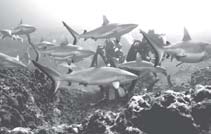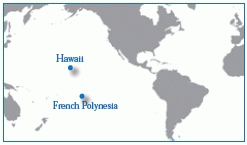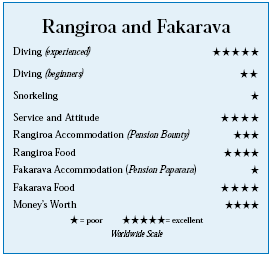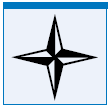Rangiroa and Fakarava, French PolynesiaContents of this Issue: Rangiroa and Fakarava, French Polynesia A Second Opinion of Kungkungan Bay Resort What Happened to Larry Smith's Liveaboard? South Pacific, South Caicos, Sudan, Utila Part II: How Many Divers Are There? Dive Equipment Insurance Claims For or Against the "No-Pee" Rule? a steady stream of reader comments Editorial Office: Ben Davison Publisher and Editor Undercurrent 3020 Bridgeway, Suite 102 Sausalito, CA 94965 paradise for pelagic fanatics from the June, 2007 issue of Undercurrent
Dear Reader: I can sum up my surface intervals in Tahiti and the Tuamotu Islands in two words: hot and expensive. My flight from Los Angeles was only eight hours but when I arrived at Papeete at 4:30 a.m., the heat and humidity hit me like a hot, wet blanket, with no air-conditioning to be found. My flight to Rangiroa wasnít until 8:30 a.m., so all I could do was swap my dollars for Pacific francs at a very poor exchange rate, then sit and sweat it out until check-in. But, oh, the diving. An abundance of pelagics, tropical reef fish, bright corals and strong currents made for excellent, challenging diving. I took a land-based itinerary, booking dives and accommodations through Top Dive, doing 14 dives in six days at Rangiroa, and nine dives in four days at Fakarava. Air Tahiti flies many hour-long flights daily to Rangiroa in twin-engine turbo props with small overhead bins. Weight limits are strict -- 55 pounds for checked baggage and seven pounds for carryons -- but I got lucky. My luggage weighed 70 pounds but because I was the first in line for check-in, tired and it was Christmas, the airline checker skipped the $40 additional charge.
About 200 miles
east of Tahiti, the
Tuamotu Archipelago
is composed of 78
coral atolls. The
largest is Rangiroa,
boasting the biggest
lagoon in Polynesia.
Alain Ruiz, the
French owner of
Pension Bounty,
met me at the airport.
The threemile
drive was on a narrow strip of road, the lagoon only 150
yards to the west and the ocean equidistant
to the east. Thereís no town center on
Rangiroa, just a few scattered hotels, pensions,
restaurants and a pearl farm up north.
Alain runs the Pension Bounty with his wife,
Muriel. Half a mile down the beach was Top Diveís site, a small shack with a compressor. I wanted an afternoon dive for Christmas Day, so Marina Delestain (she took novice divers while Pascal guided advanced ones) took me for a shallow dive at Tiputa Reef in the northern part of the atoll. It was a mellow dive, with a couple of barracuda schools floating lazily and turtles mingling with tropical fish among hard corals. The great stuff came the next day at Tiputa Pass, a short ride away. The current rips at up to 10 knots when it flows from the ocean to the lagoon, and is chock-full of hammerheads, squadrons of eagle rays and other majestic predators. Before I entered the pass, there was nothing between me and the white sand but sharks, eagle rays and barracudas of every size and type, swirling and mingling at an underwater cocktail party. One problem: I was at 100 feet when they were at 150 feet or deeper. I did 11 dives in the pass, all with 75- to 100-foot visibility. As the current picked up, it was awe-inspiring to shoot the pass with eagle rays, titan and clown triggerfish, barracudas and gray and white-tip sharks flying through on either side. Unfortunately, they were not always swimming through when I did, so the dives became redundant when I didnít have company. The Nitrox was a great 36-percent mix in 100 cu. ft. tanks. We never exceeded 100 feet, and I took the ride three times a day but with strong currents, I sucked up air. Because the diving was aggressive, dive times were generally enforced at 45 minutes or 500psi, and the group surfaced together. We traveled in Zodiacs with no more than six divers in each. I suited up beforehand, having only to strap on my tank and slip on my fins in the boat. Gearing up with that sun beating down was a chore, but the water at 84 degrees felt great once I was finally in. Pascalís group backrolled in together, dropping down immediately to get into the pass, which we entered at about 95 feet. I ducked into little valleys to get out of the current. I had to grab a rock and pull myself down because the current was that strong. White tips and gray sharks hung out with schooling trevallies. Trigger fish and rays floated by gracefully, mocking my clumsy efforts to get through the current. During our surface intervals, the two groups compared sightings. Marinaís group saw hammerheads and dolphins at their safety stops, so we both came out even. The most fun was getting back into the Zodiacs. I had to take my gear off and hand it to the captain, then fin myself back up. It made for some ugly exits. Surface intervals were at the dive shop. Top Dive provided a cooler of water but I had to provide my snacks. I was generally back from the second dive by 11:30 a.m. After a lunch break, the third dive started at 2 p.m. Besides a French couple, most of my fellow divers were from the U.S. Because we were focused on the dives, and everybody else had other accommodations away from mine, there was minimal chatter outside of comparing fish IDs. At the Pension Bounty, I was the lone American among Italians who spoke little English so conversation was at a minimum, but having meals with them was still entertaining. Meals were served picnic-style on the ownerís porch. Continental breakfast was toast with butter, jam and scrambled eggs. Dinner was always a different catch of the day, and Muriel used her French flair to top it with wonderful sauces. Desserts, only as the French can make: flan, cake and chocolate mousse. Poor Muriel seemed to be working in the kitchen day and night, but both she and Alain were friendly hosts. The daily rate included continental breakfast and dinner. I spent $20 one day just for lunch at the Kia Ora Hotelís restaurant. Later, I ordered takeout sandwiches for $7. The best deal in Rangiroa: A sandwich shack one mile away near Tiputa Pass, which served good catch-of-the-day fish sandwiches and fries for $8 to $10. I would spend my surface intervals riding my bike to Tiputa Pass, then relax under palm trees. One day, four of us advanced divers dived with Marina. The dolphins must love attractive, blonde French divemasters. I descended to 60 feet, searching for my buddy and instead found a dolphin looking back at me. It was in my face for two minutes, within armís reach, and looked me straight in the eye so I waved a hello and it posed for pictures. Each diver had one or two dolphins as escorts. They swam around us leisurely for five minutes before going on their way. I am an air hog, and combined with strong currents and 90-foot depths, I sucked it up. When I ran low on air, Marina was there with the octopus. Both she and Pascal were attentive and went out of their way to ensure everybody was enjoying every dive. Avatoru Pass is not as deep as Tiputa, bottoming out at 70 feet, but still full of sharks. Schools of silver tips hung out with white tips and gray reef sharks, the first place I saw sharks being curious instead of shy. I had to duck to avoid hitting the belly of a fat, nine-foot silver tip as he swam circles around me. I positioned myself by holding onto rocks while sharks swam around me to satisfy their curiosity. After 15 minutes of being ogled, I swam along the reef and saw a few wrasses, turtles, more sharks and an occasional ray. My second dive was a carbon copy. Avatoru had mellower waters and hard coral; not spectacular but a good contrast to the barren rock and ripping currents of Tiputa Pass. Both offered consistent pelagic action. On the last day of the year, I headed to Fakarava; itís the second largest atoll
but it makes Rangiroa look like a metropolis. First, I had to go back to Papeete, the jumping-off point for all islands. It was dark when I arrived at 6:30 p.m. Mathias, the Top Dive manager, was there to meet me and drop me off at the five-room Pension Paparara, three miles south of the village Rotoava. I found Ato, one of the owners, who had had a few too many drinks. Well, it was New Yearís Eve. But then he told me he had expected me yesterday, so he didnít have a room. It was pitch black and I had nowhere to go. Through the alcohol, he sensed my anger and finally stuck me in a mosquito-infested shack with no fan or bathroom. I knew I would have to go without hot water but I wasnít expecting to share a bathroom with five other people. To top it off, the other guests had a New Yearís Eve party right outside, with a campfire sending smoke into my room all night, so I lost the party mood. I was up at 6:30 a.m., looking for the Top Dive Shop, wanting to leave Fakarava. Everybody else, of course, was sleeping off the New Year celebrations. I finally found the dive shop, located at the upscale hotel Le Maitai. At 7:30 a.m., a hotel employee showed up and I called Lucien Schmidlin, Top Diveís owner, in Bora Bora to find a solution but he was traveling and no one else could handle travel matters. I was not happy. Mathias showed up at 8:15. He did not want to deal with this but he went down to the Pension and negotiated in French with Ato, who promised a room with a bathroom after 4 p.m. Rooms are called bungalows on the beach, but I still found mine to be substandard, basically a plywood shack with a small ceiling fan 15 feet overhead. At least the dinners were wonderful. It was fresh catch every day from Atoís sons and their fishing poles. Atoís wife, Corina, cooked the fish in vegetables and rivaled Muriel with wonderful French sauces; white rice and bread were there to soak them up. Dinners were served in a large, open-door room, with separate tables for reading and a bar area against the kitchen wall. Guests sat at the large dining table on the other end and the family joined in. The other meals were paltry. Continental breakfast was a piece of fruit, bread and jams. Lunch was an extra $20 and usually spaghetti or leftovers. One of the sons and his girlfriend spoke broken English so I had a little conversation, but I found the owners arrogant and ambivalent. However, the diving was spectacular. The hard corals were a carpet of the most vibrant colors Iíve seen underwater. Mushroom, brain and plate corals lay scattered in bommies of rainbow hues. They paired with equally dazzling tropical fish -- flame angelfish, yellowback fusiliers, Moorish idols, puffer fish, snappers of just about every type, size and color. The pelagics were also out en masse with sharks, wrasses, and great barracudas. Same for the currents. At Garuae Pass, it was at least three knots and I had to claw my way up a ridge, then down, and then back up. I rested at the top, looked up and saw the payoff: at least 75 small gray reef sharks swimming around me in the current. The Top Dive shop at Le Matai is new and nice. Rental equipment is all modern Aqua Lung and the rinse tanks are impressive. Nitrox was not yet available but the 100 cu.ft. tanks were. It was far easier to climb into this 35-foot dive boat that could sit up to 10. The other operators used Zodiacs or small boats for the 25-minute ride each way. Nice tank-holding area and a table to set cameras. I arrived at 9 a.m. for the ride to the northern pass, came back in for lunch and took off again around 2 p.m. Food options were few. Top Dive did not provide snacks and there was no place to buy any. When I asked Mathias where to go for lunch, he pointed to the Le Matai hotel restaurant, but they wanted $45. I made do with my protein bar. There wasnít much to do when not underwater, just relaxing under palm trees and watching the endless ocean. Mathias spoke excellent English but always seemed to be more concerned about dust on floors or water splashing in the rinse area then being friendly to his guest Ė me. I was disappointed we could not do three dives a day. I finally got a third one in on the last day, after pestering Mathias daily. There were multiple excuses: the current was not right or some other such B.S. I dove only the northern pass which is more than a half-mile wide. The Tamakohua Pass in the south was reported to be better because it held more concentrated sea life in a narrower pass only 200 yards wide. But I was generally the only diver, Tamakohua was two hours away and Mathias told me he needed at least four divers, so I did not press it. At tripís end, I talked to a couple who had gone Tamakohua but it had taken them three days just to arrange a boat with enough divers. They told me it was the same sea life, just more concentrated. My favorite dive was the Passe Nord Garuae. I started out swimming against a strong current and climbed up a ridge. Ahead of me were 50 sharks maneuvering through the current. I swam down into a valley 60 feet deep and at least 100 yards long. The bottom was a mixture of white sand and small, popcorn-shaped coral in soft shades of beige, purple and blue. School after school of trevallies, soldierfish, gobies, Moorish idols, sea pearch, goatfish and big-eyed beams floated motionless but casually parted as I swam through them. Above me patrolled gray sharks and five huge Napoleon wrasses. Top Dive sells dive vouchers and itís best to purchase these before starting the trip. I had saved tickets for Fakarava while in Rangiroa because I heard the former was remote, with no banks or ATMs. But Marina in Rangiroa charged me substantially more than I was quoted for extra dives. In hindsight, I didnít need all those tickets because I didnít do the three dives a day in Fakarava. After my trip, I e-mailed Lucien about my experience. Three days later, he gave me a $250 refund for my unused dive tickets and a price adjustment because of the experience at Pension Paparara, where I should have been paid to stay. If you go, demand a guarantee of three dives a day, weather permitting, as well as better accommodations. But I cannot fault the diving! The atolls donít have Palauís soft corals or biodiversity, but it is paradise for pelagic fanatics. They also hold their own in tropical reef fish and rainbow colors. Because of the strong currents, novice divers should build up their skills elsewhere so they can fully enjoy Tuamotu drift diving. Come prepared with a portable fan, lots of sunscreen and a full wallet. With those three essentials, youíll fully enjoy this side of paradise. -- S.J.
|

I want to get all the stories! Tell me how I can become an Undercurrent Online Member and get online access to all the articles of Undercurrent as well as thousands of first hand reports on dive operations world-wide
| Home | Online Members Area | My Account |
Login
|
Join
|
| Travel Index |
Dive Resort & Liveaboard Reviews
|
Featured Reports
|
Recent
Issues
|
Back Issues
|
|
Dive Gear
Index
|
Health/Safety Index
|
Environment & Misc.
Index
|
Seasonal Planner
|
Blogs
|
Free Articles
|
Book Picks
|
News
|
|
Special Offers
|
RSS
|
FAQ
|
About Us
|
Contact Us
|
Links
|
3020 Bridgeway, Ste 102, Sausalito, Ca 94965
All rights reserved.


 The four studios of Kohu wood and red
cedar are just basic settings, with a kitchenette,
bathroom and overhead fan. Bicycles
were free of charge but if I needed a ride
somewhere, Alain would accommodate.
The four studios of Kohu wood and red
cedar are just basic settings, with a kitchenette,
bathroom and overhead fan. Bicycles
were free of charge but if I needed a ride
somewhere, Alain would accommodate. That
meant another sit in the sweltering airport
with only ceiling fans to cool off
with during a two-hour wait. It was one
of the few times I couldnít wait to get
on an airplane, just for the A/C.
That
meant another sit in the sweltering airport
with only ceiling fans to cool off
with during a two-hour wait. It was one
of the few times I couldnít wait to get
on an airplane, just for the A/C. Diverís Compass: Through Top Dive, I booked 13 days and 23 dives on
both atolls for about $3,500; tips were another $350 ... Top Dive
offers Nitrox in Rangiroa at no extra charge; itís not available in
Fakarava ... It offers a prepaid 10-dive package at each atoll; for
extra dives, you can negotiate the price down but make sure you get
the price in writing ... Qantas and Air Tahiti Nui fly to Papeete from
Los Angeles, and fares start at $1,600 ... Air Tahiti offers one to
four flights daily to each atoll ... Pack light and be prepared in
light clothes when you land in Papeete ... The ATM outside the airport
bank charges a 50 percent exchange rate but itís best to exchange money in Papeete
because itís more expensive elsewhere in French Polynesia ... I recommend Pension
Bounty in Rangiroa (
Diverís Compass: Through Top Dive, I booked 13 days and 23 dives on
both atolls for about $3,500; tips were another $350 ... Top Dive
offers Nitrox in Rangiroa at no extra charge; itís not available in
Fakarava ... It offers a prepaid 10-dive package at each atoll; for
extra dives, you can negotiate the price down but make sure you get
the price in writing ... Qantas and Air Tahiti Nui fly to Papeete from
Los Angeles, and fares start at $1,600 ... Air Tahiti offers one to
four flights daily to each atoll ... Pack light and be prepared in
light clothes when you land in Papeete ... The ATM outside the airport
bank charges a 50 percent exchange rate but itís best to exchange money in Papeete
because itís more expensive elsewhere in French Polynesia ... I recommend Pension
Bounty in Rangiroa (